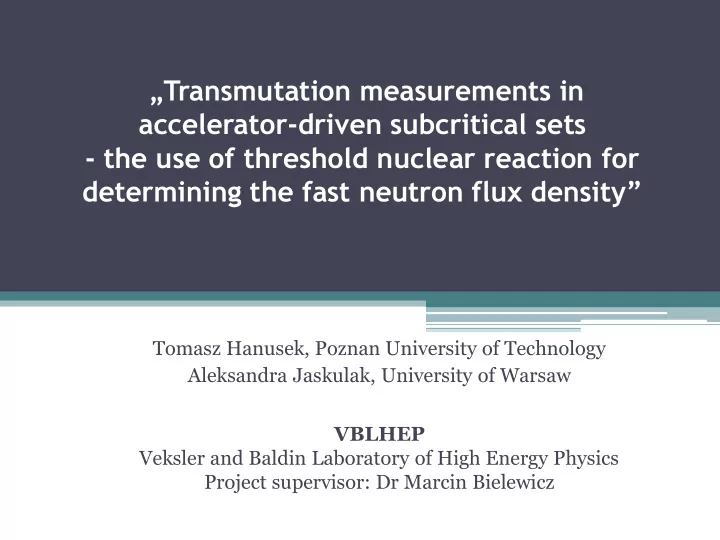

„ Transmutation measurements in accelerator-driven subcritical sets - the use of threshold nuclear reaction for determining the fast neutron flux density” Tomasz Hanusek, Poznan University of Technology Aleksandra Jaskulak, University of Warsaw VBLHEP Veksler and Baldin Laboratory of High Energy Physics Project supervisor: Dr Marcin Bielewicz
The aim of the project was the research about neutron flux in the experimental assembly based on natural uranium and proton beam from accelerator („Quinta” experiment , 2015). To gain the knowledge about the neutron flux, a threshold reaction was used. The better knowledge about neutron flux density could be useful to constructing the fourth generation and accelerator-driven subcritical nuclear rectors. Outline 1. „Quinta” experiment. 2. Measurement of gamma rays by HPGe detector. 3. Energy calibration and spectre s analysis using „ Deimos ” program. 4. Calibration formula – B parameter. 5. Results for isotopes production - B parameter. 6. Calculations for average neutron flux. 7. Conclusions.
1 . „Quinta” experiment. The Quinta assembly, consists of a total of 512 kg of natural uranium. It is composed of five sections, 114 mm long and separated by a 17 mm air gap. The uranium cylindrical rods, 36 mm in diameter, 104 mm in length and 1.72 kg in mass. The Quinta is surrounded by lead bricks 100 mm thick on all six sides of total weight 1780 kg. Shield work as a neutron reflector and as a biological shielding for γ -rays. In the front is a square window for the beam (150x150 mm).
1. „Quinta” experiment. Each QUINTA section is separated by a 17 mm air gap which allows the placement of samples mounted onto special plates. We have 6 plates (measurements positions) - 4 gaps between assembly sections and two positions in front of and rear assembly. In the experiment we irradiatied the uranium target and our samples using the proton beam from DUBNA cyclotron. The beam energy was 660 MeV and finaly we colected about 10 15 primary particles.
2. Measurement of gamma rays by HPGe detector.
2. Measurement of gamma rays by HPGe detector. Laden cover, germanium crystal and measure positions. Germanium HPGe detector and leaden cover.
3. Energy Calibration and spectres analysis using „Deimos” program. 190,79 keV 86Y 1836,063 keV 88Y Samples: Y89 (stable) Threshold reactions: Y89(n,2n)Y88, Y89(n,3n)Y87, Y89(n,4n)Y86, Y89(n,5n)Y85
3. „Deimos” program.
4. Calibration formula – B parameter (a) - B parameter normalization (includes mass of the sample, peak area and total number of particles - protons) (b) - all correction except parts with time calibration (c) - time of experiment calibration (d) - calibration considering time between experiment and measurement gamma rays (e) - time of measurement gamma rays calibration
5. Results for isotopes production - B parameter. Spacial distribution for isotope Y- 87 Y89(n,3n)Y87 3,50E-05 B[nuclei/g/proton] 3,00E-05 2,50E-05 660 MeV proton beam 2,00E-05 0 1,50E-05 1,00E-05 4.0 R [cm] 5,00E-06 8.0 0,00E+00 12 0 1 (13.1) 2 (26.2) 3 (39.3) 4 (52.4) 5 (65.5) Distance from the front of the target [cm]
5. Results for isotopes production - B parameter. Radial distribution for isotope Y- 88 Y89(n,2n)Y88 1,40E-04 1,20E-04 1,00E-04 B [nuclei/g/proton] 898,042 S2 8,00E-05 1836,063 S2 6,00E-05 4,00E-05 2,00E-05 0,00E+00 0 4 8 12 Radius [cm]
6. Calculations for average neutron flux. where: B y - parameter B for the isotope S – total number of protons from accelerator, which incide on the detector during the experiment A - Avogadro constans t – time of irradiation [s] σ – average cross-section for reaction (n,xn) in particular energy range [barn] G – gramoatom for the isotope
6. Calculations for average neutron flux. Average neutron flux density for the energy range 11,5 to 20,8 MeV neutron flux density [1/cm2 /MeV/GeV/proton] 660 MeV 2,00E-03 proton beam 1,50E-03 0 1,00E-03 4.0 5,00E-04 R [cm] 8.0 0,00E+00 12 0 1 (13.1) 2 (26.2) 3 (39.3) 4 (52.4) 5 (65.5) Distance from the front of the Quinta target [cm] 11,5 – 20,8 MeV (n,2n) We divided energy range into 3 parts 20,8 – 32,7 MeV (n,3n) because of threshold reactions. 32,7 – 100 MeV (n,4n)
7. Conclusions. Parameters of „Quinta” assembly were very similar to conditions provided in the ADS reactors. After the experiment it’s able to make measurements which gives us the isotopes level productions. Basing on the measurements, using knowledge about nuclear reactions and parameter equations we were able to assign the average neutron flux density inside our experimental assembly. Our results are compatible with expectations from previous experiments.
Thank you for your attention
where: B - number of nuclei per gram of a sample material and per one primary particle N 1 - peak (line) area N abs - the absolute intensity of given line in percent [%] p (E) - detector efficiency function of energy (polynomial) COI(E,G) - cascade effect coefficient function of energy and geometry ∆S(G), ∆D(E) - calibrations function for thickness and shape of detectors I - total number of primary particles Λ - decay constant ( λ=ln(2)/t 1/2 ) t 1/2 - half life time [s] t ira - elapsed time of irradiation [s] t + - time between the end of irradiation and the beginning of measurement [s] t real - time of the measurement [s] m - mass of the sample (target) [g] It was assumed that the main contribution to value B error came from statistical error, N 1 and I number error .
Recommend
More recommend